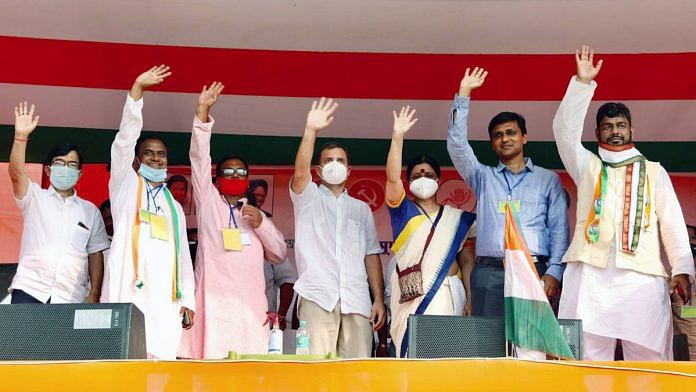New Delhi: The Congress party has been cut to size in the West Bengal assembly election results announced Sunday. As of the Election Commission trends at 4 pm Sunday, the party is leading just one seat, having registered a zero through most of the day.
Its partners, the CPI(M) and the newly formed Indian Secular Front, lead in one seat each, giving the alliance a lead in just three seats. As counting progresses, the Congress might claw back some ground, but it will still count as a dismal performance, which will weigh on the state leadership and workers.
The party had never expected to do phenomenally in Bengal — it was aware and comfortable knowing it would be number three in what was slated to be a bipolar contest between Mamata Banerjee’s ruling Trinamool Congress and a formidable challenger in the BJP. However, some Congress members did expect a double-digit seat tally, even close to its previous mark of 44 out of 92 seats.
“This has been truly gutting, we didn’t think we would perform this poorly in the election. I am in a state of utter shock,” said a West Bengal Congress leader on the condition of anonymity.
Yet, other Congress leaders said the party had it coming — with its lacklustre campaign, rifts within the alliance, lack of a strategy to attack TMC and BJP effectively, and a sense among the party cadre of being abandoned by the national leadership.
Also read: Five reasons why Mamata Banerjee is set to sweep Bengal despite a BJP surge
No attention from national leadership
While both the BJP and the TMC upped the ante during their campaigns, panning over several months, the Left-Congress alliance was missing in action for the longest time.
The eight-phase West Bengal elections began on 27 March, but Rahul Gandhi didn’t show up in the state until 14 April, after four phases were over. After conducting just two rallies, on 18 April, he announced he was suspending all public meetings and rallies due to the Covid spike.
“We understand why the rallies had to be cancelled, but he shouldn’t have waited until last minute to show up in the state. That was really demotivating for the party workers. Emphasis shouldn’t just be on ‘winnable’ states — all states should be treated as important,” a second West Bengal Congress leader said.
Rahul Gandhi was scheduled to campaign in the remaining four phases, where important Congress strongholds such as Malda and Murshidabad were set to vote. On Sunday afternoon, the Congress candidate in these two seats was trailing at number three, behind the BJP and TMC, each of whom were leading one.
Internal rifts, lack of consistent messaging
Some more Congress leaders cited lack of a focused strategy to attack TMC and BJP as a reason for this heavy defeat.
“BJP’s entry complicated things for us. Now we were compelled to fight two mammoth bodies, instead of one. But we should have pushed ourselves as the reliable alternative to BJP, especially in the minority-populated constituencies. We failed to do that,” a third state Congress leader said.
Leaders also cited internal rifts in the alliance, and confusion over seats as a reason behind the loss. Adhir Ranjan Chowdhury, the party’s West Bengal president and leader in the Lok Sabha, had a cold equation with alliance partner ISF’s leader, Furfura Sharif cleric Abbas Siddiqui, with both parties eyeing Muslim votes.
Like in other states, there were also several rifts within the Congress, with national leaders like Anand Sharma expressing disagreements and displeasure over the alliance with ISF, and Chowdhury hitting back saying such statements were “helping the BJP”.
Lack of uniform and consistent messaging from the party at all levels wasn’t just confusing for the voters but also the party workers, the third leader quoted above said.
Another factor that complicated matters was that while the Congress was in alliance with the Left in Bengal, it was leading a sharp attack against the party in Kerala.
“When your messaging is all over the place, it just shows you as an underconfident, unsure and defeated party. That’s what happened,” the third leader said.
(Edited by Shreyas Sharma)
Also read: Why BJP’s Bengal blitzkrieg and Modi-Shah attacking Mamata have failed



